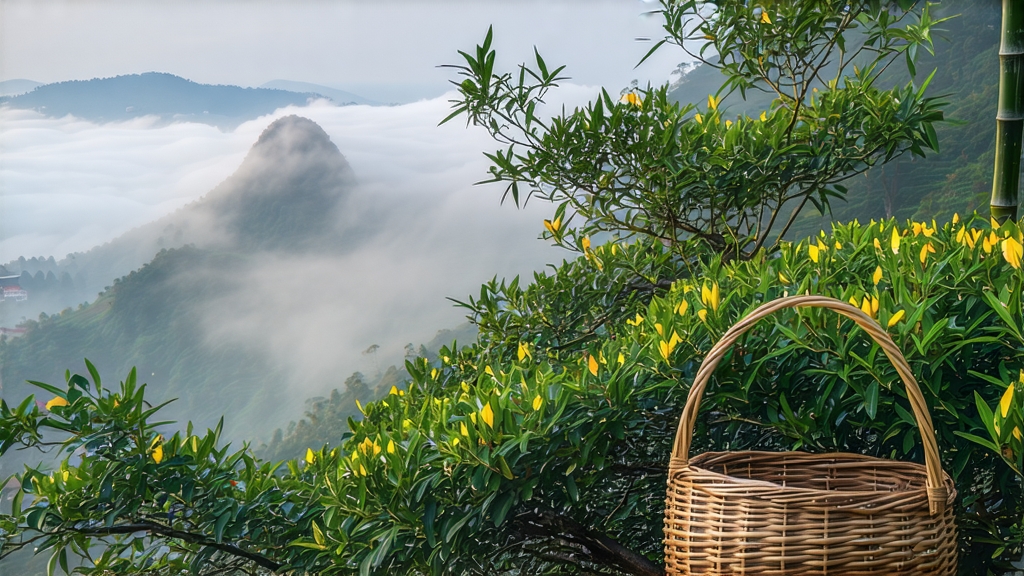
High on Mengding Mountain, where Sichuan’s mist rolls over ridges older than the Han dynasty, a tea once reserved for emperors still unfurls its secrets one golden bud at a time. Mengding Huangya—literally “Yellow Bud of Mengding”—is the least-known member of China’s noble yellow-tea family, yet its story carries the fragrance of every dynasty that ever sent caravan bells echoing across the Tea-Horse Road. To meet it is to step into a chronicle of monks, merchants, and mandarins who believed that a single sip could align the drinker with heaven.
History: From Altar of Heaven to Obscurity
The first written record appears in 825 CE, when the Tang court recorded “Mengding Shi Hua” as one of five mountain tributes presented at the Altar of Heaven. By Song times, monks at the Ganlu Temple on the summit were already refining a slow-oxidation technique that turned green leaf into pale gold, a process they called “men huang”—sealed yellowing. Imperial appetite grew so fierce that during Ming’s Yongle reign, 500 soldiers guarded the mountain for the three spring weeks when the single-bud plucking standard was enforced. When Qing trade routes shifted eastward toward Fujian oolongs, Mengding Huangya retreated into monastery gardens, surviving only because local hill tribes bartered it for salt. Thus the tea slept, largely forgotten, until a 1959 state expedition rediscovered 300 ancient shrubs hidden in cloud forest at 1,400 m.
Terroir: Where Clouds Write the Flavor
Mengding’s microclimate is a textbook example of “three clouds a day.” Warm, moist air from the Sichuan basin collides with cold Himalayan draughts, creating fog that lingers until noon, burns off, then reconvenes at dusk. The result is a low-light, high-humidity environment that forces the tea bush to synthesize more theanine and fewer catechins, gifting the leaf its signature sweet-broth texture. Soils are purple sandstone rich in selenium and zinc, while overnight temperature swings can exceed 15 °C, locking floral precursors inside the tender buds.
Garden Craft: Picking the Dawn Dew
Official designation restricts raw material to two standards: “Single Bud” (taken when the apical leaf has not yet unfurled) and “One Bud with One Initial Leaf” (no longer than 2.5 cm). Picking begins at 05:30, when dew weight still exceeds 6 %, because evaporative loss triggers enzymatic browning too early. Experienced pluckers use a twist-and-lift motion that keeps the bud stem unbroken; any rupture will leak polyphenol oxidase and stain the yellow liquor later. Daily yield per worker is barely 400 g fresh leaf, explaining why finished Mengding Huangya often retails above silver-grade Dragon Well.
Withering: The Invisible First Breath
Unlike green tea’s immediate killing-green, yellow tea demands a 3–4 hour indoor wither on bamboo trays stacked inside a draft-free corridor. Ambient temperature is held at 28 °C with 75 % humidity; the goal is to reduce moisture to 68 % while allowing a faint grassy note to evaporate. Masters gauge readiness by listening: when the leaf loses its squeaky “green voice” and begins to rustle like silk, it is ready for the next metamorphosis.
Sealed Yellowing: The Heart of Alchemy
This is the step that earns the tea its color and name. After a brief 90-second shaqing (pan-firing at 160 °C to halt oxidative enzymes), the leaf is immediately wrapped in thick linen bundles—historically, the monks used oiled rice paper—then stacked inside a bamboo steamer. Core temperature is maintained at 35 °C for 48 hours, during which residual moisture and trapped oxygen coax a non-enzymatic browning reaction. Chlorophyll degrades into pheophytin, catechins dimerize into theaflavins, and a mellow cocoa aroma emerges. Every six hours the master unwraps, fluffs, and re-bundles the leaf to ensure even yellowing; uneven bundles emerge mottled green and fetch half price.
Bamboo Firing: Scent of Mountain Smoke
Once the leaf has turned a uniform pale chamois, it is given three low-temperature firings on a bamboo charcoal b